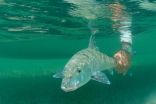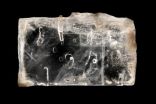(Press-News.org) Nov. 22, 2010 -- More than 170 participants gathered this week for the eighth annual National Academies Keck Futures Initiative (NAKFI) conference in Irvine, Calif. This year's topic, imaging science, a field of study that uses physics, chemistry, mathematics, computer science, and cognitive sciences to understand the many factors that influence and enable image capture and analysis. At the conference, top researchers from different fields discussed imaging science and its far-reaching applications -- such as astronomy, environmental monitoring, education, and health care -- and how it can be used to solve complex problems.
Farouk El-Baz, director of the Center for Remote Sensing, Boston University, and this year's conference chair, challenged attendees to push imaging science forward in a nonlinear way. "The promise of imaging science" El-Baz said, "could come from identifying tools and validation methods to develop clinically useful non-invasive imaging biomarkers of psychiatric disease, developing a telescope or starshade to reveal planetary systems around neighboring stars, or developing new ways to detect and classify meaningful changes between two images so that we can determine whether a crop is flourishing or withering, for example, or determine whether a tumor is responding to treatment." He added, "The think-tank format of the NAKFI conference – which focuses on assigning challenges for attendees to solve – will push the limits and move the field of imaging science forward in unexpected ways through the imagination of its participants."
During the conference, researchers grouped into teams to explore core issues common to all imaging applications. Each team received a research challenge. Among the challenges were to think of new applications for imaging; improve image processing and recovery; enhance image analysis and understanding; and measure image quality objectively. They also discussed the future of visualization. Graduate students, representatives from public and private funding organizations, government, industry, and the media also partook in the discussions.
To encourage further interdisciplinary work, the Futures Initiative announced the availability of $1 million in seed grants -- up to $100,000 each -- for new lines of research identified at the conference. Recipients of the competitive grants will be announced in the spring.
To help participants overcome differences in terminology used in various fields, experts in those fields presented a series of webcast tutorials on many aspects of imaging science. These tutorials are available online.
INFORMATION:
Launched in 2003 by the National Academies and the W.M. Keck Foundation, the Futures Initiative is a 15-year effort to stimulate interdisciplinary inquiry and to enhance communication among researchers, funding agencies, universities, and the general public. The initiative builds on three pillars of vital and sustained research: interdisciplinary encounters that counterbalance specialization and isolation; exploration of new questions; and bridging languages, cultures, habits of thought, and institutions through communication. For more information on the Futures Initiative, visit www.keckfutures.org.
The National Academy of Sciences, National Academy of Engineering, Institute of Medicine, and National Research Council make up the National Academies. They are private, nonprofit institutions that provide science, technology, and health policy advice under a congressional charter. For more information, visit www.national-academies.org.
Contacts: William Skane, Executive Director
Maureen O'Leary, Director of Public Information
Office of News and Public Information
202-334-2138; e-mail news@nas.edu
[ This news release is available at http://national-academies.org ]
END
Johns Hopkins Children's Center scientists have discovered that high blood levels of a protein commonly found in the central nervous system can predict brain injury and death in critically ill children on a form of life support called extra-corporeal membrane oxygenation or ECMO.
ECMO, used to temporarily oxygenate the blood of patients whose heart and lungs are too weak or damaged to do so on their own, is most often used as a last resort because it can increase the risk for brain bleeding, brain swelling, stroke and death in some patients.
A detailed report of the ...
HIV infected patients whose treatment is delayed not only become sicker than those treated earlier, but also require tens of thousands of dollars more in care over the first several years of their treatment.
"We know that it's important clinically to get people into care early because they will stay healthier and do better over the long run," says Kelly Gebo, M.D., M.P.H., an associate professor of medicine in the Division of Infectious Diseases at the Johns Hopkins University School of Medicine and the study's senior author. "But now we know it's also more costly to ...
You detect an object flying at your head. What do you do? You probably first move out of the way -- and then you try to determine what the object is. Your brain is able to quickly switch from detecting an object moving in your direction to determining what the object is through a phenomenon called adaptation.
A new study in the Nov. 21 advance online edition of the journal Nature Neuroscience details the biological basis of this ability for rapid adaptation: neurons located at the beginning of the brain's sensory information pathway that change their level of simultaneous ...
MIAMI – November 22, 2010 – This October more than 60 guides and anglers in the Florida Keys poled across the flats from Biscayne Bay to the Marquesas, assisting in the annual bonefish census. This year's count, held in extremely difficult weather with lowered visibility, was down by 25-percent from an 8-year mean estimate of 316,805 bonefish to a new low of about 240,000 bonefish, according to Professor Jerry Ault, a fisheries scientist with the University of Miami's Rosenstiel School of Marine & Atmospheric Science.
"Since 2003 we have conducted an annual bonefish ...
In the future, tiny air vehicles may be able to fly through cracks in concrete to search for earthquake victims, explore a contaminated building or conduct surveillance missions for the military. But today, designing the best flying mechanism for these miniature aerial machines is still a challenging task.
Creating micro-scale air vehicles that mimic the flapping of winged insects or birds has become popular, but they typically require a complex combination of pitching and plunging motions to oscillate the flapping wings. To avoid some of the design challenges involved ...
From fad diets to exercise programs, Americans continue to fight the battle of the bulge. Now they'll have help from recent Tel Aviv University research that has developed a new method to look at how fat cells -- which produce the fat in our bodies -- respond to mechanical loads.
This might be the key to understanding how to control the amount of fat produced by fat cells, the holy grail of weight loss researchers, says Prof. Amit Gefen of Tel Aviv University's Department of Biomedical Engineering. His research is driven by the theory that fat cells, like bone or muscle ...
Fresh insight into how biological clocks adjust to having less sunlight in the winter could help us better understand the impact of jet lag and shift work.
Scientists studying the daily activity cycle in plants – known as circadian rhythms – have discovered a finely tuned process that enables the plant's genes to respond to the times of dawn and dusk each day, as well as the length of daylight in between.
This system helps the plant to reset its internal clock every day in response to seasonal changes in daylight, which helps the plant control the timing of key activities ...
Infants are more efficient at digesting and utilizing nutritional components of milk than adults due to a difference in the strains of bacteria that dominate their digestive tracts. Researchers from the University of California, Davis, and Utah State University report on genomic analysis of these strains in the November 2010 issue of the journal Applied and Environmental Microbiology identifying the genes that are most likely responsible for this difference.
"Human milk oligosaccharides (HMOs) are the third-largest solid component of milk. Their structural complexity ...
Direct contact and droplets are the primary ways influenza spreads. Under certain conditions, however, aerosol transmission is possible. In a study published in the current issue of Clinical Infectious Diseases, available online (http://www.journals.uchicago.edu/doi/abs/10.1086/656743), the authors examined such an outbreak in their own hospital in Hong Kong.
On April 4, 2008, seven inpatients in the hospital's general medical ward developed fever and respiratory symptoms. Ultimately, nine inpatients exhibited influenza-like symptoms and tested positive for influenza ...
BINGHAMTON, NY – Binghamton University researchers recently revived ancient bacteria trapped for thousands of years in water droplets embedded in salt crystals.
For decades, geologists have looked at these water droplets — called fluid inclusions — and wondered whether microbes could be extracted from them. Fluid inclusions have been found inside salt crystals ranging in age from thousands to hundreds of millions years old.
But there has always been a question about whether the organisms cultured from salt crystals are genuinely ancient material or whether they are ...



